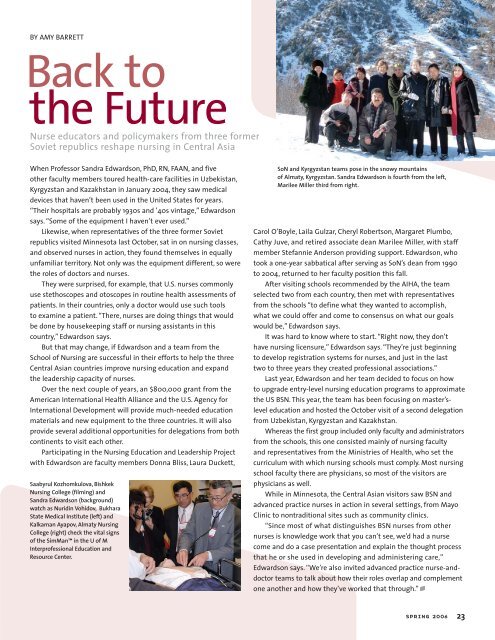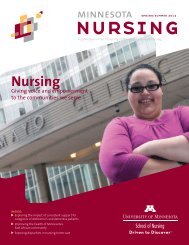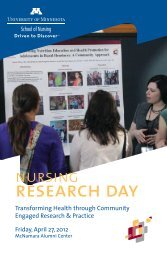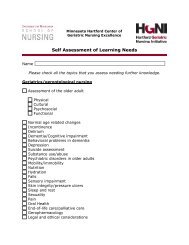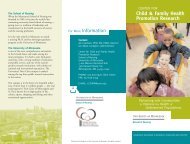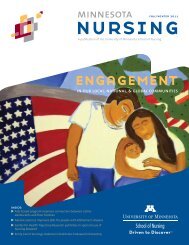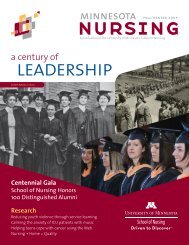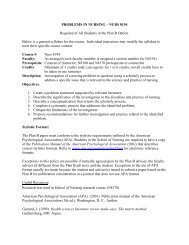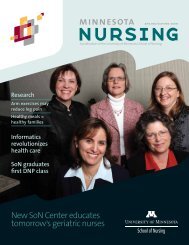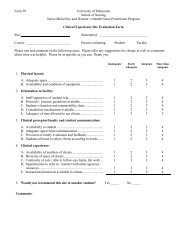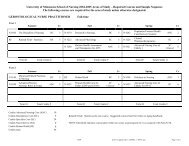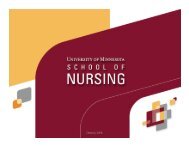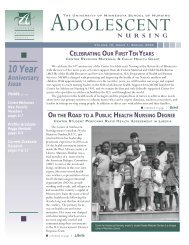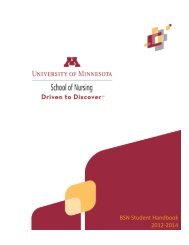Introducing Connie Delaney - School of Nursing - University of ...
Introducing Connie Delaney - School of Nursing - University of ...
Introducing Connie Delaney - School of Nursing - University of ...
Create successful ePaper yourself
Turn your PDF publications into a flip-book with our unique Google optimized e-Paper software.
BY AMY BARRETT<br />
Back to<br />
the Future<br />
Nurse educators and policymakers from three former<br />
Soviet republics reshape nursing in Central Asia<br />
When Pr<strong>of</strong>essor Sandra Edwardson, PhD, RN, FAAN, and five<br />
other faculty members toured health-care facilities in Uzbekistan,<br />
Kyrgyzstan and Kazakhstan in January 2004, they saw medical<br />
devices that haven’t been used in the United States for years.<br />
“Their hospitals are probably 1930s and ’40s vintage,” Edwardson<br />
says. “Some <strong>of</strong> the equipment I haven’t ever used.”<br />
Likewise, when representatives <strong>of</strong> the three former Soviet<br />
republics visited Minnesota last October, sat in on nursing classes,<br />
and observed nurses in action, they found themselves in equally<br />
unfamiliar territory. Not only was the equipment different, so were<br />
the roles <strong>of</strong> doctors and nurses.<br />
They were surprised, for example, that U.S. nurses commonly<br />
use stethoscopes and otoscopes in routine health assessments <strong>of</strong><br />
patients. In their countries, only a doctor would use such tools<br />
to examine a patient. “There, nurses are doing things that would<br />
be done by housekeeping staff or nursing assistants in this<br />
country,” Edwardson says.<br />
But that may change, if Edwardson and a team from the<br />
<strong>School</strong> <strong>of</strong> <strong>Nursing</strong> are successful in their efforts to help the three<br />
Central Asian countries improve nursing education and expand<br />
the leadership capacity <strong>of</strong> nurses.<br />
Over the next couple <strong>of</strong> years, an $800,000 grant from the<br />
American International Health Alliance and the U.S. Agency for<br />
International Development will provide much-needed education<br />
materials and new equipment to the three countries. It will also<br />
provide several additional opportunities for delegations from both<br />
continents to visit each other.<br />
Participating in the <strong>Nursing</strong> Education and Leadership Project<br />
with Edwardson are faculty members Donna Bliss, Laura Duckett,<br />
Saabyrul Kozhomkulova, Bishkek<br />
<strong>Nursing</strong> College (filming) and<br />
Sandra Edwardson (background)<br />
watch as Nuridin Vohidov, Bukhara<br />
State Medical Institute (left) and<br />
Kalkaman Ayapov, Almaty <strong>Nursing</strong><br />
College (right) check the vital signs<br />
<strong>of</strong> the SimMan in the U <strong>of</strong> M<br />
Interpr<strong>of</strong>essional Education and<br />
Resource Center.<br />
SoN and Kyrgyzstan teams pose in the snowy mountains<br />
<strong>of</strong> Almaty, Kyrgyzstan. Sandra Edwardson is fourth from the left,<br />
Marilee Miller third from right.<br />
Carol O’Boyle, Laila Gulzar, Cheryl Robertson, Margaret Plumbo,<br />
Cathy Juve, and retired associate dean Marilee Miller, with staff<br />
member Stefannie Anderson providing support. Edwardson, who<br />
took a one-year sabbatical after serving as SoN’s dean from 1990<br />
to 2004, returned to her faculty position this fall.<br />
After visiting schools recommended by the AIHA, the team<br />
selected two from each country, then met with representatives<br />
from the schools “to define what they wanted to accomplish,<br />
what we could <strong>of</strong>fer and come to consensus on what our goals<br />
would be,” Edwardson says.<br />
It was hard to know where to start. “Right now, they don’t<br />
have nursing licensure,” Edwardson says. “They’re just beginning<br />
to develop registration systems for nurses, and just in the last<br />
two to three years they created pr<strong>of</strong>essional associations.”<br />
Last year, Edwardson and her team decided to focus on how<br />
to upgrade entry-level nursing education programs to approximate<br />
the US BSN. This year, the team has been focusing on master’slevel<br />
education and hosted the October visit <strong>of</strong> a second delegation<br />
from Uzbekistan, Kyrgyzstan and Kazakhstan.<br />
Whereas the first group included only faculty and administrators<br />
from the schools, this one consisted mainly <strong>of</strong> nursing faculty<br />
and representatives from the Ministries <strong>of</strong> Health, who set the<br />
curriculum with which nursing schools must comply. Most nursing<br />
school faculty there are physicians, so most <strong>of</strong> the visitors are<br />
physicians as well.<br />
While in Minnesota, the Central Asian visitors saw BSN and<br />
advanced practice nurses in action in several settings, from Mayo<br />
Clinic to nontraditional sites such as community clinics.<br />
“Since most <strong>of</strong> what distinguishes BSN nurses from other<br />
nurses is knowledge work that you can’t see, we’d had a nurse<br />
come and do a case presentation and explain the thought process<br />
that he or she used in developing and administering care,”<br />
Edwardson says. “We’re also invited advanced practice nurse-anddoctor<br />
teams to talk about how their roles overlap and complement<br />
one another and how they’ve worked that through.”<br />
spring 2006<br />
23


